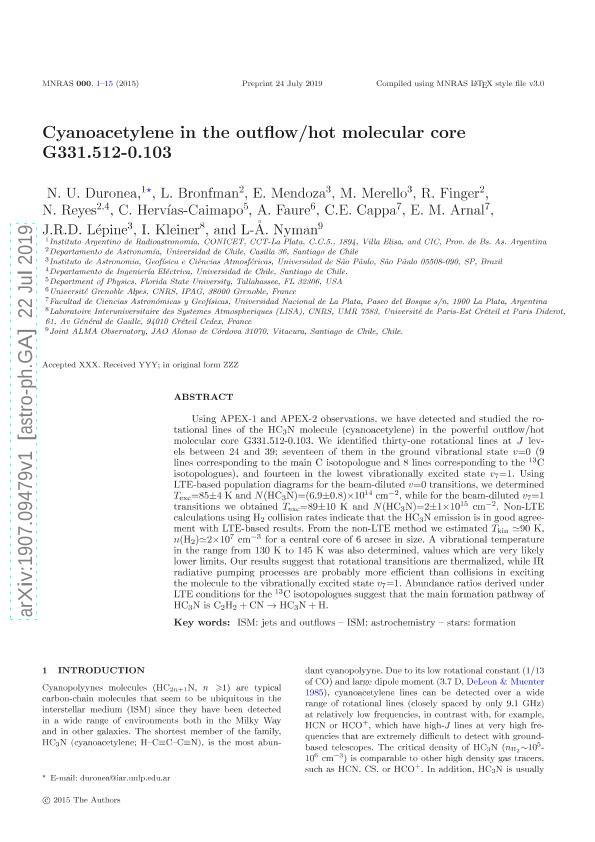Artículo
Cyanoacetylene in the outflow/hot molecular core G331.512-0.103
Duronea, Nicolas Urbano ; Bronfman, L.; Mendoza, E.; Merello, Manuel; Finger, Ricardo; Reyes, Nicolas; Hervias Caimapo C.; Faure, A.; Cappa, Cristina Elisabeth
; Bronfman, L.; Mendoza, E.; Merello, Manuel; Finger, Ricardo; Reyes, Nicolas; Hervias Caimapo C.; Faure, A.; Cappa, Cristina Elisabeth ; Arnal, Edmundo Marcelo
; Arnal, Edmundo Marcelo ; Lepine, Jacques; Kleiner, I.; Åke Nyman, Lars
; Lepine, Jacques; Kleiner, I.; Åke Nyman, Lars
 ; Bronfman, L.; Mendoza, E.; Merello, Manuel; Finger, Ricardo; Reyes, Nicolas; Hervias Caimapo C.; Faure, A.; Cappa, Cristina Elisabeth
; Bronfman, L.; Mendoza, E.; Merello, Manuel; Finger, Ricardo; Reyes, Nicolas; Hervias Caimapo C.; Faure, A.; Cappa, Cristina Elisabeth ; Arnal, Edmundo Marcelo
; Arnal, Edmundo Marcelo ; Lepine, Jacques; Kleiner, I.; Åke Nyman, Lars
; Lepine, Jacques; Kleiner, I.; Åke Nyman, Lars
Fecha de publicación:
07/2019
Editorial:
Wiley Blackwell Publishing, Inc
Revista:
Monthly Notices of the Royal Astronomical Society
ISSN:
0035-8711
Idioma:
Inglés
Tipo de recurso:
Artículo publicado
Clasificación temática:
Resumen
Using APEX-1 and APEX-2 observations, we have detected and studied the rotational lines of the HC3N molecule (cyanoacetylene) in the powerful outflow/hot molecular core G331.512-0.103. We identified thirty-one rotational lines at J levels between 24 and 39; seventeen of them in the ground vibrational state v=0 (9 lines corresponding to the main C isotopologue and 8 lines corresponding to the 13C isotopologues), and fourteen in the lowest vibrationally excited state v7=1. Using LTE-based population diagrams for the beam-diluted v=0 transitions, we determined Texc=85±4 K and N(HC3N)=(6.9±0.8)×1014 cm−2 , while for the beam-diluted v7=1 transitions we obtained Texc=89±10 K and N(HC3N)=2±1×1015 cm−2 . Non-LTE calculations using H2 collision rates indicate that the HC3N emission is in good agreement with LTE-based results. From the non-LTE method we estimated Tkin ≃90 K, n(H2)≃2×107 cm−3 for a central core of 6 arcsec in size. A vibrational temperature in the range from 130 K to 145 K was also determined, values which are very likely lower limits. Our results suggest that rotational transitions are thermalized, while IR radiative pumping processes are probably more efficient than collisions in exciting the molecule to the vibrationally excited state v7=1. Abundance ratios derived under LTE conditions for the 13C isotopologues suggest that the main formation pathway of HC3N is C2H2 + CN → HC3N + H.
Palabras clave:
Jets
,
Astrochemistry
,
Formation of stars
,
Outflows
Archivos asociados
Licencia
Identificadores
Colecciones
Articulos(IAR)
Articulos de INST.ARG.DE RADIOASTRONOMIA (I)
Articulos de INST.ARG.DE RADIOASTRONOMIA (I)
Citación
Duronea, Nicolas Urbano; Bronfman, L.; Mendoza, E.; Merello, Manuel; Finger, Ricardo; et al.; Cyanoacetylene in the outflow/hot molecular core G331.512-0.103; Wiley Blackwell Publishing, Inc; Monthly Notices of the Royal Astronomical Society; 489; 2; 7-2019; 1519-1532
Compartir
Altmétricas



